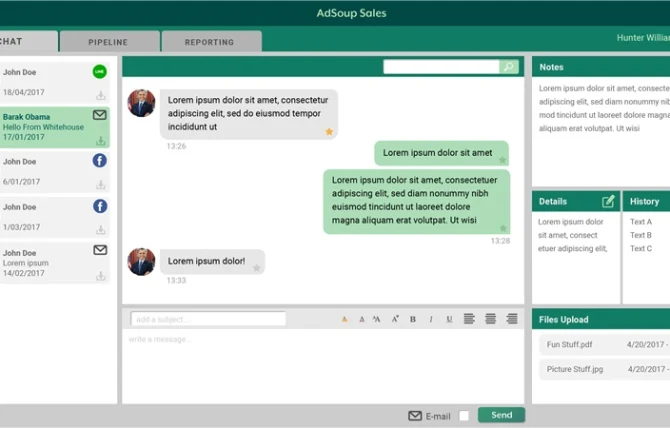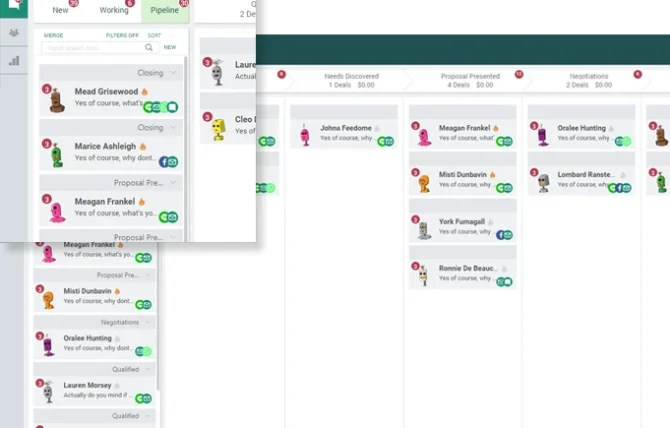AdSoup was founded after the realization of a significant gap in the customer communication landscape. While running a digital marketing agency in Asia, the challenge was evident: multiple communication channels resulted in unresponded messages, leading to lost client revenue.
There was also a major issue with tracking the ROI from social media campaigns to actual sales, since the initial communication channel often went unrecorded in traditional CRMs.
This problem was especially acute in Asia, where communication via platforms like Facebook Messenger, WhatsApp, Line, and Telegram dominated customer-business interactions.
Email was less prevalent than in the West, leaving many regional companies without a centralized tool to effectively aggregate and manage these conversations. Despite the plethora of communication channels, there was no singular place to aggregate them into a sales tool, allowing businesses to manage a sale predominantly through these chats and pipelines while effectively attributing the sale back to its originating channel. This realization was the turning point for creating AdSoup.

Features and Development
AdSoup was designed to integrate multiple communication channels seamlessly, such as WhatsApp, Line, Facebook Messenger, email, and website chat. The core concept was to provide businesses with a singular chat-style dashboard where sales and customer support teams could communicate with customers across channels efficiently.
This unified platform ensured that conversations could be threaded into one view, even if they spanned multiple channels like Messenger and email.
Multi-Channel Integration: AdSoup combined WhatsApp, Line, Facebook Messenger, email, and website chat into one platform. However, this required overcoming significant technical challenges. For instance, WhatsApp did not have an official API then, so a custom solution was built to enable messaging integration.
Similarly, Line had a very basic API, and integrating with it involved overcoming several technical limitations. These integrations ensured businesses could handle inquiries from different channels without switching between platforms.
Unified Communication: The platform aggregated conversations from various channels into a unified thread, enabling businesses to track customer interactions from start to finish.
This comprehensive view allowed salespeople to respond to customer queries efficiently and move leads through the sales pipeline.
Sales Pipeline Management: AdSoup’s integrated sales tool allowed sales teams to move leads through different sales pipeline stages. The platform ensured that each communication could be tracked and attributed to its originating channel, providing a comprehensive overview of the sales journey.

Technical Challenges
Building AdSoup was a technically complex endeavour. The varying API capabilities of the different platforms necessitated custom-built solutions for each integration, especially WhatsApp.
The platform also had to handle real-time chat across multiple platforms, aggregating them into a single conversation view. Due to the high volume of conversations, the initial choice of Firebase for database management proved inadequate, indicating the need for a more robust platform.
Moreover, the APIs available then were not mature enough to handle the platform’s requirements. Integrating email services was particularly challenging, as many users preferred using their existing email clients, and migrating them to a new system proved difficult. This led to technical debt that required substantial investment to overcome, but the growth was insufficient to attract further funding.
Target Market and Impact
AdSoup primarily targeted small to medium businesses in Asia, specifically those with two or more sales teams and limited resources. These businesses often had sales and customer service teams working with the same tools.
They needed a straightforward, affordable solution that could streamline communication across multiple channels and provide essential CRM functionalities without the complexity of expensive platforms like Salesforce.
Enabling Fast Responses: The platform enabled sales teams to respond quickly to potential leads, significantly reducing the number of lost leads. The ability to instantly respond on any channel improved lead conversion rates, as businesses could now engage with customers promptly and effectively.
Streamlining Communication: AdSoup brought all channels into a single dashboard, allowing businesses to streamline their communications and sales processes. The integrated sales pipeline management tools made it easier to manage leads and attribute sales to their originating channels.
Success and Learnings
Despite launching with minimal funding, AdSoup achieved significant success in its early stages. At its peak, the platform had around 2,500 paying users who accessed its services. This growth was a testament to the platform’s ability to address a critical market need for Asian businesses.
Key Learnings
Technical Debt: AdSoup’s rapid development led to significant technical debt. The custom solutions and workarounds used for integrating various platforms were not sustainable in the long term, necessitating a significant investment to rebuild the system. This challenge was compounded by the lack of growth required to attract further funding.
Integration Challenges: Integrating email services into AdSoup was an immense task. In hindsight, focusing on integrating into existing email clients like Gmail might have been more effective. The need to create custom solutions for platforms that lacked official APIs also added to the complexity.
Future Outlook
The demand for multi-channel CRMs, especially in Asia, remains high. Despite the challenges faced during AdSoup’s development, the need for a unified communication platform is still evident. However, the lack of robust APIs and a unified API aggregation service complicate implementation.
Opportunities: There is still a significant opportunity for a multi-channel CRM tailored to the Asian market. By addressing the challenges of aggregating messages from multiple platforms and enabling seamless customer communication, such a tool could unlock new potential for regional businesses.
In conclusion
Entrepreneurs looking to build similar products should focus on integrating with platforms that provide stable APIs and consider leveraging existing email management tools like Gmail.
The lessons from AdSoup highlight the importance of building on solid technical foundations to ensure scalability and sustainability.
In summary, AdSoup was a groundbreaking multi-channel CRM that addressed a critical market need in Asia. Despite the challenges, the platform’s success demonstrates the significant demand for tools that can aggregate communication channels and streamline sales processes.
